In pictures: Vince Clarke and Paul Hartnoll's transatlantic studios
Electronic music maestros combine forces (and boutique vintage synthesizer collections) to fashion the sublime dance-centric, 2Square. 
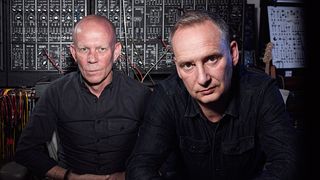
2Square
Vince Clarke (Depeche Mode, Yazoo, The Assembly, Erasure) and Paul Hartnoll (Orbital and excellent solo albums) have given us some ecstatic moments of electronic joy over the years. Both men share a love of collecting (and getting the most from) desirable synthesizers of all shapes and sizes and, thankfully, both share a keyboard tech who was instrumental in connecting the two synth legends together for the brilliant, resultant 2Square collaboration.
Whether it’s the shimmering modular sequences of Underwater, pristine debut single Better Have A Drink To Think or the serotonin- stomp of Do-a-Bong, Clarke and Hartnoll fuse their not-inconsiderable talents together to wonderful effect. With a gear list that reads like a veritable history of analogue synths, 2Square was born of transatlantic stems flying back and forth between Clarke’s new Brooklyn studio and Hartnoll’s Brighton HQ, where the two convened to finalise and mix the whole thing.
We were delighted to catch up with Vince in his new Brooklyn synth-lair and Paul in his Brighton nerve centre to find out more about the making of 2Square... not to mention some of those incredible synths!
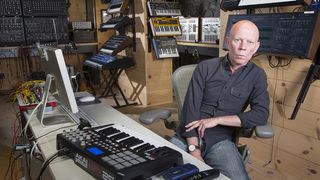
Vince Clarke
What inspired you to approach Paul about possibly collaborating on something?
“It actually came about as I’d been working on tracks for a while on my own and going around in circles a bit. Then a mutual friend of myself and Paul’s suggested I meet up with Paul. We happened to be in Brighton, where Paul lives, on tour so we hooked up and hit it off straightaway. It wasn’t a plan; it was just one of those happenings. I didn’t know Paul and I only really knew Orbital through our mutual keyboard tech, actually.”
When you met was Paul instantly up for the pair of you working together?
“Well, I think he was a bit dubious at first. I mean, I had about six or seven tracks that I’d started. Paul’s a very sensible person so he didn’t just dive in and say, ‘yeah,I can sort this out for you, mate’.
“It was more a case of him saying he would get some ideas together, try them out and see if I liked it. So, that happened over a period of time and then, when the ideas started flowing back and forth, we decided that the best thing to do would be to actually get together in his studio and finish the record off there and make it a real joint effort.”
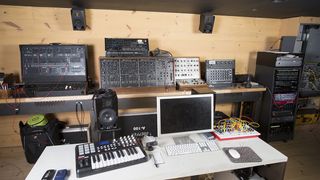
Remote working
What great times we live in that you can fly tracks back and forth across the Atlantic for each other to work on?
“It is but there are also limitations in as much as, what I really enjoyed about doing this album was the last section, where Paul and I were in the studio for a week together. He and I can both work remotely but, when you’ve done that for ten years it gets a bit lonely. It seriously does.
“When I started doing music back in the day, you were always surrounded by other people... engineers, producers – whereas now you can do everything in your bedroom. It can be a bit disconnected and sad.”
So, you preferred the one-to-one feedback of working as a unit in the studio?
“Yeah and also, the problem when you work alone is that you end up going around in circles without someone else there to say, ‘that’s good enough’ or ‘that’s not good enough’. So, it was great to have that connection right at the end of the record.”
How long did everything take – from your early demos to putting the final mixes down to releasing it on your new Very Records imprint?
“Three years. I had this idea of maybe starting a little record company and I really had to sell it to Paul. I said, ‘I know I’ve never done this properly before but I’m really excited about the idea and I think it could be really good’. I said that our project could be a fantastic launch platform for the label and Paul was kind enough to consider that I might be competent enough to do it.”
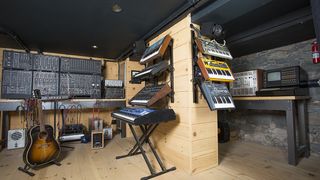
Brooklyn-bound
When we spoke a few years back you surprised us by saying you wrote most of Erasure’s songs on piano and acoustic guitar. Would we be right in assuming this wasn’t the case with the 2Square songs?
“After working with Martin (Gore) on the VCMG project I really got into this whole minimal/ Techno-ish, synth music so I started just doing vibe music and getting some grooves going and some musical events. That was the skeletons that I gave to Paul when he got onboard.”
Did you set any rules for what was or wasn’t allowed with the songs?
“It was pretty free actually as we were working as a team. It was a collaboration rather than us having set roles. I guess the only ‘rule’ we set ourselves was to make it ‘dancey’.”
You’ve relocated to Brooklyn from your Cabin studio. What gear made the move with you?
“Well, basically I had the Cabin in Maine and I just moved the entire operation here. I’m down in a basement in Brooklyn, which still kind of looks like the Cabin as it’s all wooden walls. I’ve got it all here and, in fact, it’s probably more operational than my place in Maine.”
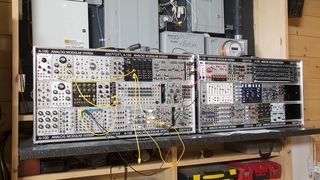
The comfort zone
So what were your ‘go-to’ bits of kit for these sessions?
“Well, there are always my favourites like the ARP 2600 and the Pro One. I have started exploring the whole Eurorack thing too and that’s amazing... a whole new world, in fact. It’s not an environment I’m completely comfortable with yet but it’s really fun to mess about and experiment with.”
We were going to ask later what you thought about the resurgence of modular synthesizers...
“It did surprise me as it wasn’t something I ever expected to happen but I think it’s really fantastic. There are some really creative people out there making some seriously interesting shit. [laughs] For geeks, it’s fantastic.”
You’ve released some modular units with Analogue Solutions, haven’t you?
“We did a couple of units. The VCM20 AutoTune is a utilitarian unit to keep synthesizers in tune. I kind of conceptualised it, then my brother, who is a genius, did all the work and made the actual thing. The Imaginator is a sequencer module that we both worked on... and when I say ‘both worked on’, I mean I said it and he did it!”
When we’ve spoken before you’ve been using a lot of soft synths in your process but 2Square sounds a very ‘hardware’ driven album?
“It is, yeah. Apart from some effects and EQs then I reckon 99% of it is all external synthesizers. I’m not dissing soft synths as they are an amazing resource but, for myself, and I’m sure, for Paul, it’s much more fun to have the ability to use two hands rather than just a mouse. It’s the physicality of using hardware synths that makes it a bonus when you’re making electronic music.”
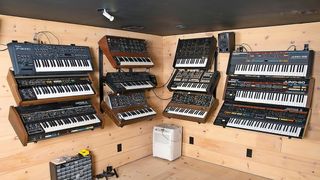
MIDI is massive
Is it still Logic you work in and was that how you sent stems between you and Paul?
“Both Paul and I are using Logic X as our basic recording stations. Because we’re both using the same thing, it means that if I send Paul over the recording of a sound I can also include the MIDI information so, if he wants to change the sound without re-programming it then he can use that. That makes the whole operation much more fluid.”
So is MIDI still playing a big part in the writing process for you both?
“Well, Logic is MIDI. I’ve been on Logic for quite a long time and I really like it. Most people I know are either Logic or Pro Tools but I still think, for me as a programmer/sequencer-type person, Logic comes very naturally. The impression I get is that Pro Tools is more of an alternative 24-track recording studio and not quite so much geared towards sequencing – it’s more about the actual recording. That said, they’re both amazing programs.”
Back in the days when you were programming on rudimentary ARP sequencers did you ever envisage something with the sequencing potential of Logic?
“You could never really imagine what would happen and, to be honest, it took me a long time to go from a basic MIDI sequencer on to using Logic. I couldn’t really use a mouse for a long time and that took a bit to get used to. At the end of the day these things are all tools and things become easier to use or there are more choices but that isn’t necessarily always a good thing. The nice thing about working with analogue, mostly monophonic, synthesizers is that you have to make decisions, which means eventually your record gets finished!”
Software does have the capacity to leave us drifting, decision-less for days, doesn’t it?
“Forever! Someone asked me the other day about why I’ve never done a solo record and I said because it would never be finished! When I embark on a new project I try and impose certain restrictions – whether that’s to keep it totally analogue or keep it completely monophonic. That’s mainly to make sure that you stretch yourself a bit.”
Writing purely monophonic synth parts is definitely an interesting discipline…
“Yeah... I’m working on the next Erasure record now and the original demos have lots of block chords and piano stuff going on so what I try and do is, say there’s a five-note chord happening in a part, then I’ll divide that chord into five different notes and use five different synthesizers to play each note. It just gives it a different texture and vibe that I think is really cool.”
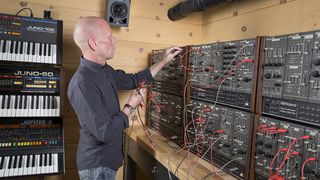
Going live?
How has it been getting your hands dirty at the business end of things with the new label?
“To be honest, I really didn’t know what I was doing in the beginning... [laughs] I still don’t know everything, obviously, so, for Paul, it was a bit of a leap of faith. It’s been a great starting point to get everything launched. It’s been a real learning process too. I mean, I really didn’t appreciate what PR people do... you know what I mean? ...until I actually started working on this.
“You kind of take everything for granted whereas now, having my hands in every part of the process, I’ve started to really appreciate what, for instance, Mute do for me. There are so many details, which is the thing I think that really shocked me. It wasn’t so much that it’s hard graft, rather that there are so many things to think about and that there are consequences to every move you make and contact you make... It’s been fascinating, really.”
You mention about knowing the System-100 well; is that something we maybe miss out on nowadays – that idea of really getting to know what a synth/soft synth is actually capable of?
“You know why that is, don’t you? If you spend £1,000 on an analogue synthesizer that’s a big investment, whereas if you spend maybe £100 on a soft synth then you look at the presets and think, ‘they’re quite good!’. Also, a lot of the soft synths, though not all of them, are quite difficult to program. The reason they have a thousand presets is that someone has spent a lot of hours creating them. It’s a bit like the DX7 back in the day... it was incredibly difficult to program and at the end of the day the presets sounded much better than anything you could possibly do on your own.”
Over and above the Pro One and ARP 2600 what other synths did you use on the album?
“I used quite a bit of the Roland System-700 and also the 100m, which I really love as I know it so well. There’s also an Oberheim OB-mx rack; I’ve got a few of those happening and they’re all CV/gate synthesizers. My favourite newish synth has to be the Dave Smith Mopho. I love that synth, man! I’ve listened to all the stuff Dave Smith has being doing but there’s something about the Mopho... it has an amazing sound.”
Have Paul and yourself got any plans to take this out into the live arena at some point?
“We don’t really know yet. For me, it’s dipping a toe in the water situation; the reason that it’s download- only at the moment is that I didn’t know how it would go down. So, we’re just taking it as it comes for the moment. I’d love to do something live... it would be cool in a festival situation, which is what Paul is all about. That might hopefully be a possibility in the future. As far as the label is concerned then I’ve got a few other projects brewing; the next release is something completely different from the project Paul and I have done and that should be coming out later this year.”
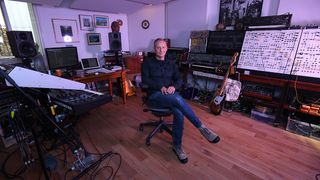
Paul Hartnoll
What was your initial reaction when Vince contacted you about the possibility of collaborating on some stuff?
“Excitement! He’s one of those people that I’ve seen around a few times – I was at the Ivor Novello awards when he won a lifetime achievement award and I went up to shake his hand and say congratulations and made a right tit of myself... like you do!
“What can someone say other than thanks, really! Vince’s music has been in my world since we got our very first video recorder and I taped Top Of The Pops with Depeche Mode doing New Life... that was the first thing I taped! The first Depeche album and first Yazoo album had a big influence on me. We both obviously share a love of Kraftwerk as well.
“We share a backline tech, Howard, who was the mate who hooked us up together. He’d always said to me that I’d get on with Vince so when Vince needed someone to help out with the demos he had for this album, it was Howard that suggested that he talk to me. So, we met up in a pub in Brighton to talk about it.”
Was part of the process being able to let go a little bit of your creation and allow each other to work your ideas into one another’s music?
“Absolutely. There was one track that I was having trouble with, then I realised that was because I was fighting it. I was trying to turn it into something it wasn’t. So I changed and just enhanced what it already was, then it all fell into place.”
We mentioned to Vince that it sounded quite a ‘hardware-based’ album... Was that the case from your end of proceedings to?
“Actually, to be fair, it’s a mixture as anything I ever do always is. [laughs] I love going to Gear Slutz and watching all the bickering over hardware vs software or analogue vs digital! My thing is... does it make a good sound? Is it any good? Although, I do have a room full of ridiculously expensive analogue synths – most of which I bought before they were ridiculously expensive!
“I did, in my head, say at the outset let’s make it using a lot of hardware, but at the same time, if something sounds good and I know it’s software then I wouldn’t change it as there’d be no point. There’s a certain wildness that happens when you compose in software, break it out into hardware then record each line separately while tweaking away at it all. The whole thing comes alive in a really unusual way.
“The track Underwater was done like that. It was quite static at first and the original demo wasn’t full of tweaked synths. I liked all the synths that were going on so I just added a couple of bits and replaced some of the static lines with some moving analogue synths. Of course, when you do one, open up the filter and close it at certain points then it starts to build an arrangement within the arrangement of getting bigger and smaller. Then you superimpose on top of it so it becomes like painting these layers of sound over the top of each other and it tends to swell, ebb and flow in its own little way. That is definitely a hardware attribute.”
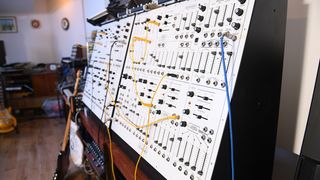
Same same, but different
Speaking with you a few years back, you’d just got yourself a Macbeth modular... Have you gone any deeper into the modular rabbit hole?
“I’ve got two meagre little racks of Eurorack but I don’t really go there too often if I can help it. I’ve got a Make Noise system – it’s a one-unit rack of all their weird, esoteric stuff that’s basically a West Coast-style system. I’ve got a few waveshapers, complex wave envelopes and the odd nice oscillator but that’s about it. I’ve got lots of semi-modular things; there’s two Macbeth M5Ns, an ARP 2600, Roland System-100 and 100m, so if you combine them with a little bit of Eurorack it’s great fun. I don’t view them all as completely separate entities, more as one big system.”
Those Macbeth modulars have a very different/ unique sound, don’t they?
“The two Macbeth M5Ns I have sound different from each other! If I’m going to have a Macbeth moment I’ll look at them both and decide which it’s going to be as one is definitely a bit fizzier and more open and the other one is a bit darker.”
So what specific gear did you bring to the table for 2Square?
“Now, Vince said he was going to put a list up of that but I brought the Make Noise modular, the ARP 2600, both Macbeths, System-100m, the Oberheim Xpander, Jupiter-8 and on top of that the Korg version of the ARP Odyssey, which is really good. My Bass Station II for something slightly more modern. That was mostly it for the hardware.”
What about software? For the project and also stuff you use in general?
“Software-wise it’s Ableton, always. Although I did most of this album in Logic as that’s where Vince works. That was interesting as it got me back into learning Logic again as I’d always been a Logic user prior to Ableton, which I now prefer. In Logic I love Sculpture. I love physical modelling synths and it’s brilliant. That’s something that’s not in the hardware world either.
“I like Native Instruments’ stuff a lot; Reaktor in particular. Oh and there’s one thing I almost forgot... just to be a show off. I’ve got a SunSyn Mark II. It’s a purple one, number 11 of a run of ten! He made ten and by the time I got in touch they’d all gone and I said, ‘you can’t do that to me,’ so he said, for me, he’d do one more.”
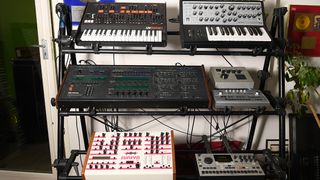
Tools for all jobs
Nice to see the high regard you’re held in by Jomox. Did the SunSyn live up to expectation when you got it?
“Yes but it took a bit of learning as it’s very much its own beast. You have to kind of learn what it’s good at but, as soon as I got it,I did a whole filmscore with it, which was great. It’s an unusual machine, very luscious, very brassy and it’s what I imagine a CS80 to sound like. It can sound quite aggressive too. I know the orange Mk1s can be upgraded to sound like a Mk2.”
Did your toolkit for 2Square differ greatly from what you’d find yourself using for your own music?
“No... it’s the same, really. The only difference was psychological in that you’re doing something with someone else so you try not to be selfish. You open it up to thinking ‘that’s what they like’ even if you’re not sure about something... you work around it anyway. It’s not a compromise in the sense that, when you listen back to it you think, ‘how did that happen? I wouldn’t have done that on my own?’
“There are a lot of bits on this album that I listen to and I don’t even know what I make of! They sound great but I wouldn’t have done it if it had just been me. If that element of surprise didn’t happen then I guess there wouldn’t have been much point doing it!”
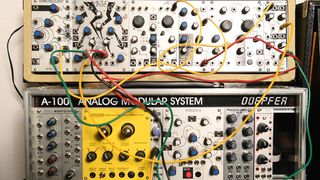
Tag team
Did you feel like you upped your game for working with Vince or was it just cool that the pair of you hit it off so well?
“I don’t know... did I up my game? I’ll tell you what, it was a lot of fun [laughs] so I’m not sure I upped my game as that sounds like I normally don’t do something I should be doing. It was a pure pleasure.”
You’ll be pleased to hear that Vince said similar – he particularly enjoyed the pair of you working together at your place in Brighton…
“That was definitely the best bit because I’ve never been so productive as we were in that week. We only did six days and often finished at 4 o’clock in the afternoon so there was no messing about. The thing is, we worked like a tag team swapping roles as and when it was required. There was always one of us with an idea and always something going on.”
Not knowing when to actually call something finished is a real problem with electronic music. Is that something you suffer from?
“No, I think one of my best skills is always knowing when to finish. Creating a piece of art, you always start out with this notion that you’re going to create the perfect piece of art; you never do – nobody ever does! So, you have to know when to stop once you’ve hit a certain level and it’s as good as it’s going to be. Then you move on and start making another piece of art with the idea of making that the most perfect piece of art. It’s a question of being cavalier enough to say, ‘that’ll do’.”
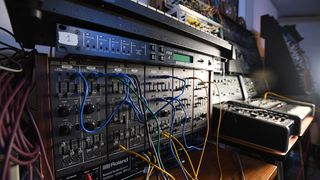
No synths allowed
Were any mixing desks involved in the final process or was everything kept in the box?
“All done in the box down here in Brighton. I do all my mixing in the box these days anyway. It’s the one digital thing that I love. I grew up mixing on desks and it can sound great that way but it can sound great in the box too. I think recording real hardware as the instruments and then mixing in the box, if you like, would be better than using loads of soft synths then mixing on a desk, if you know what I mean? You capture the rawness and the ‘out of the box-ness’ when you make the recordings so then mixing in the box is fine. Loads of amazing kind of Folk music and other stuff is done in the box now and it sounds brilliant.”
Anything the pair of you worked on that didn’t end up making the cut?
“I don’t think there was, really. We had a couple of demos each that never made the final album but they were ones that never got worked on; in that kind of way that, for every 10-track album there was probably 13 tracks and you pick the best ones.”
Have you got any plans for working together beyond 2Square?
“Not at the moment... let’s get this album flying first! I’m doing a lot of TV work at the moment and I’m trying to concentrate on that. I’m negotiating doing the music for an eight-part TV series. That offers up some new challenges... [laughs], especially as it’s set in the 1700s and I’m not allowed to use synthesizers!”
From Orbital to madrigals...
“[laughs] You’d be surprised how similar they are! You’ve just got to play it on a lute instead. That’s been good fun doing that – I’ve really enjoyed it. I enjoyed doing Peaky Blinders for the same reason that I wasn’t allowed to use synths there either. It’s freeing as it’s actually quite nice to be told not to use your main instrument!”
For more Vince and Paul go to Erasure and Paul's websites. 2Square is available for download from Very Records.

Future Music is the number one magazine for today's producers. Packed with technique and technology we'll help you make great new music. All-access artist interviews, in-depth gear reviews, essential production tutorials and much more. Every marvellous monthly edition features reliable reviews of the latest and greatest hardware and software technology and techniques, unparalleled advice, in-depth interviews, sensational free samples and so much more to improve the experience and outcome of your music-making.


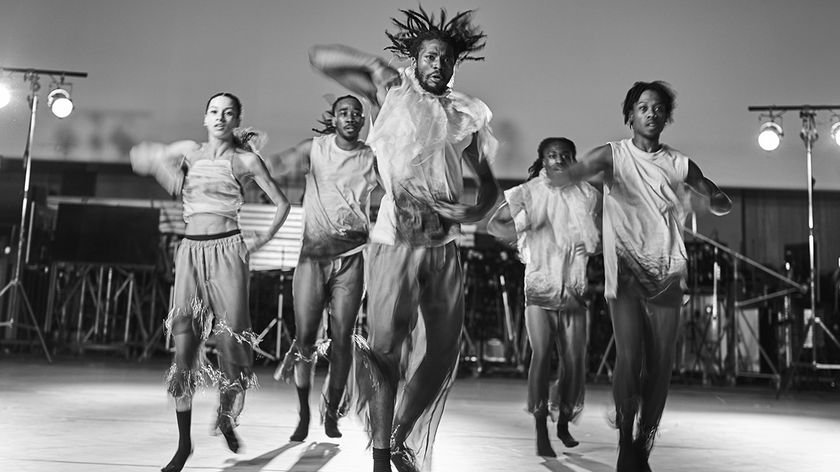
Refurbished Abbey Road Studio One reopens with evening of "boundary-pushing expressive dance" that blends styles from ballet to hip-hop and krump - and a new mixing desk

“I was like, ‘man - this is the energy’”: Billie Eilish’s mix engineers reveal the star's “favourite part” of her smash hit, Birds Of A Feather

Refurbished Abbey Road Studio One reopens with evening of "boundary-pushing expressive dance" that blends styles from ballet to hip-hop and krump - and a new mixing desk

“I was like, ‘man - this is the energy’”: Billie Eilish’s mix engineers reveal the star's “favourite part” of her smash hit, Birds Of A Feather



![Chris Hayes [left] wears a purple checked shirt and plays his 1957 Stratocaster in the studio; Michael J. Fox tears it up onstage as Marty McFly in the 1985 blockbuster Back To The Future.](https://cdn.mos.cms.futurecdn.net/nWZUSbFAwA6EqQdruLmXXh-840-80.jpg)






